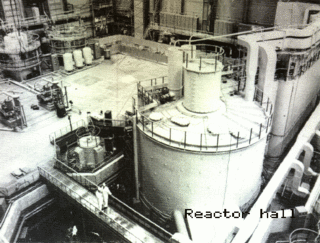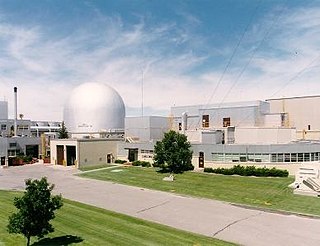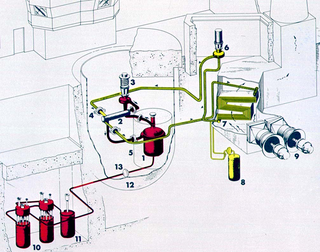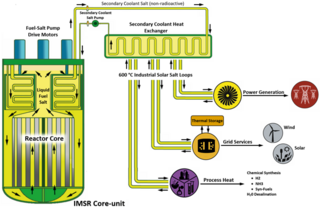Related Research Articles

A nuclear reactor is a device used to initiate and control a fission nuclear chain reaction or nuclear fusion reactions. Nuclear reactors are used at nuclear power plants for electricity generation and in nuclear marine propulsion. Heat from nuclear fission is passed to a working fluid, which in turn runs through steam turbines. These either drive a ship's propellers or turn electrical generators' shafts. Nuclear generated steam in principle can be used for industrial process heat or for district heating. Some reactors are used to produce isotopes for medical and industrial use, or for production of weapons-grade plutonium. As of 2022, the International Atomic Energy Agency reports there are 422 nuclear power reactors and 223 nuclear research reactors in operation around the world.

A pressurized water reactor (PWR) is a type of light-water nuclear reactor. PWRs constitute the large majority of the world's nuclear power plants. In a PWR, the primary coolant (water) is pumped under high pressure to the reactor core where it is heated by the energy released by the fission of atoms. The heated, high pressure water then flows to a steam generator, where it transfers its thermal energy to lower pressure water of a secondary system where steam is generated. The steam then drives turbines, which spin an electric generator. In contrast to a boiling water reactor (BWR), pressure in the primary coolant loop prevents the water from boiling within the reactor. All light-water reactors use ordinary water as both coolant and neutron moderator. Most use anywhere from two to four vertically mounted steam generators; VVER reactors use horizontal steam generators.

A nuclear meltdown is a severe nuclear reactor accident that results in core damage from overheating. The term nuclear meltdown is not officially defined by the International Atomic Energy Agency or by the United States Nuclear Regulatory Commission. It has been defined to mean the accidental melting of the core of a nuclear reactor, however, and is in common usage a reference to the core's either complete or partial collapse.

A fast-neutron reactor (FNR) or fast-spectrum reactor or simply a fast reactor is a category of nuclear reactor in which the fission chain reaction is sustained by fast neutrons, as opposed to slow thermal neutrons used in thermal-neutron reactors. Such a fast reactor needs no neutron moderator, but requires fuel that is relatively rich in fissile material when compared to that required for a thermal-neutron reactor. Around 20 land based fast reactors have been built, accumulating over 400 reactor years of operation globally. The largest of this was the Superphénix Sodium cooled fast reactor in France that was designed to deliver 1,242 MWe. Fast reactors have been intensely studied since the 1950s, as they provide certain advantages over the existing fleet of water cooled and water moderated reactors. These are:

A loss-of-coolant accident (LOCA) is a mode of failure for a nuclear reactor; if not managed effectively, the results of a LOCA could result in reactor core damage. Each nuclear plant's emergency core cooling system (ECCS) exists specifically to deal with a LOCA.
In nuclear engineering, the void coefficient is a number that can be used to estimate how much the reactivity of a nuclear reactor changes as voids form in the reactor moderator or coolant. Net reactivity in a reactor is the sum total of multiple contributions, of which the void coefficient is but one. Reactors in which either the moderator or the coolant is a liquid typically will have a void coefficient value that is either negative or positive. Reactors in which neither the moderator nor the coolant is a liquid will have a void coefficient value equal to zero. It is unclear how the definition of "void" coefficient applies to reactors in which the moderator/coolant is neither liquid nor gas.

The light-water reactor (LWR) is a type of thermal-neutron reactor that uses normal water, as opposed to heavy water, as both its coolant and neutron moderator; furthermore a solid form of fissile elements is used as fuel. Thermal-neutron reactors are the most common type of nuclear reactor, and light-water reactors are the most common type of thermal-neutron reactor.
Passive nuclear safety is a design approach for safety features, implemented in a nuclear reactor, that does not require any active intervention on the part of the operator or electrical/electronic feedback in order to bring the reactor to a safe shutdown state, in the event of a particular type of emergency. Such design features tend to rely on the engineering of components such that their predicted behaviour would slow down, rather than accelerate the deterioration of the reactor state; they typically take advantage of natural forces or phenomena such as gravity, buoyancy, pressure differences, conduction or natural heat convection to accomplish safety functions without requiring an active power source. Many older common reactor designs use passive safety systems to a limited extent, rather, relying on active safety systems such as diesel-powered motors. Some newer reactor designs feature more passive systems; the motivation being that they are highly reliable and reduce the cost associated with the installation and maintenance of systems that would otherwise require multiple trains of equipment and redundant safety class power supplies in order to achieve the same level of reliability. However, weak driving forces that power many passive safety features can pose significant challenges to effectiveness of a passive system, particularly in the short term following an accident.

The integral fast reactor is a design for a nuclear reactor using fast neutrons and no neutron moderator. IFR would breed more fuel and is distinguished by a nuclear fuel cycle that uses reprocessing via electrorefining at the reactor site.

A molten-salt reactor (MSR) is a class of nuclear fission reactor in which the primary nuclear reactor coolant and/or the fuel is a mixture of molten salt with a fissionable material.

Nuclear fuel is material used in nuclear power stations to produce heat to power turbines. Heat is created when nuclear fuel undergoes nuclear fission.
Generation IVreactors are nuclear reactor design technologies that are envisioned as successors of generation III reactors. The Generation IV International Forum (GIF) – an international organization that coordinates the development of generation IV reactors – specifically selected six reactor technologies as candidates for generation IV reactors. The designs target improved safety, sustainability, efficiency, and cost. The World Nuclear Association in 2015 suggested that some might enter commercial operation before 2030.

A sodium-cooled fast reactor is a fast neutron reactor cooled by liquid sodium.

The Molten-Salt Reactor Experiment (MSRE) was an experimental molten salt reactor research reactor at the Oak Ridge National Laboratory (ORNL). This technology was researched through the 1960s, the reactor was constructed by 1964, it went critical in 1965, and was operated until 1969. The costs of a cleanup project were estimated at $130 million.

The liquid fluoride thorium reactor is a type of molten salt reactor. LFTRs use the thorium fuel cycle with a fluoride-based molten (liquid) salt for fuel. In a typical design, the liquid is pumped between a critical core and an external heat exchanger where the heat is transferred to a nonradioactive secondary salt. The secondary salt then transfers its heat to a steam turbine or closed-cycle gas turbine.

The hydrogen-moderated self-regulating nuclear power module (HPM), also referred to as the compact self-regulating transportable reactor (ComStar), is a type of nuclear power reactor using hydride as a neutron moderator. The design is inherently safe, as the fuel and the neutron moderator is uranium hydride UH3, which is reduced at high temperatures (500–800 °C) to uranium and hydrogen. The gaseous hydrogen exits the core, being absorbed by hydrogen absorbing material such as depleted uranium, thus making it less critical. This means that with rising temperature the neutron moderation drops and the nuclear fission reaction in the core is dampened, leading to a lower core temperature. This means as more energy is taken out of the core the moderation rises and the fission process is stoked to produce more heat.

The Integral Molten Salt Reactor (IMSR) is a nuclear power plant design targeted at developing a commercial product for the small modular reactor (SMR) market. It employs molten salt reactor technology which is being developed by the Canadian company Terrestrial Energy. It is based closely on the denatured molten salt reactor (DMSR), a reactor design from Oak Ridge National Laboratory. In addition, it incorporates some elements found in the SmAHTR, a later design from the same laboratory. The IMSR belongs to the DMSR class of molten salt reactors (MSR) and hence is a "burner" reactor that employs a liquid fuel rather than a conventional solid fuel. This liquid contains the nuclear fuel as well as serving as the primary coolant.

The Thorcon nuclear reactor is a design of a molten salt reactor with a graphite moderator, proposed by the US-based Thorcon company. These nuclear reactors are designed as part of a floating power plant, to be manufactured on an assembly line in a shipyard, and to be delivered via barge to any ocean or major waterway shoreline. The reactors are to be delivered as a sealed unit and never opened on site. All reactor maintenance and fuel processing is done at an off-site location. As of 2022, no reactor of this type has been built. A prototype of 500Mw (TMSR-500) output should be activated in Indonesia by 2029.

The Stable Salt Reactor (SSR) is a nuclear reactor design under development by Moltex Energy Canada Inc. and its subsidiary Moltex Energy USA LLC, based in Canada, the United States, and the United Kingdom, as well as MoltexFLEX Ltd., based in the United Kingdom.
References
- ↑ Mortensen, Cecilie Als (2 September 2022). "Jagter kæmpe millionbeløb: Dansk firma vil udvikle fremtidens atomkraft". Finans (in Danish). Retrieved 13 November 2022.
- ↑ "Advances in Small Modular Reactor Technology Developments". International Atomic Energy Agency. Published August 2016. Retrieved 2017-02-07
- 1 2 3 Waldrop, M. Mitchell (22 February 2019). "Nuclear goes retro — with a much greener outlook". Knowable Magazine. doi: 10.1146/knowable-022219-2 . S2CID 186586892.
- ↑ "Dansk reaktor brænder farligt atomaffald". DR (in Danish). 20 August 2015. Retrieved 17 June 2021.
- ↑ "Seaborg Technologies". Seaborg. Retrieved 17 November 2019.
- 1 2 3 4 5 Blain, Loz (15 June 2021). "Mass-produced floating nuclear reactors use super-safe molten salt fuel". New Atlas. Retrieved 17 June 2021.
- 1 2 "OUR TECHNOLOGY". Seaborg. Retrieved 11 August 2023.